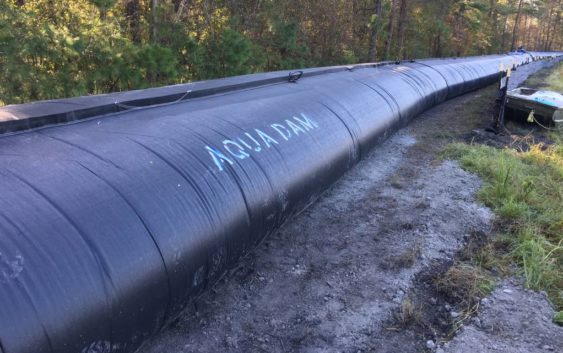- Fake job seekers are flooding the market, thanks to AI
- One set of evacuation orders lifted in Caldwell County after wildfire contained
- 'We gutted every building' | Chimney Rock rebuilding after Hurricane Helene
- 'We gutted every building' | Chimney Rock rebuilding after Hurricane Helene
- Debris from Hurricane Helene provides fuel, complicates containment for spring wildfires
How will an inflatable dam protect your drinking water during the coming floods?

Santee Cooper’s latest effort to ensure its stockpile of coal ash in Conway stays out of the Waccamaw River involves 6,000 feet of water-inflated flood-control barriers.
The AquaDam structures will be assembled next to the fencing along Pond 2’s dike at the now-demolished Grainger Generating Station, according to a Santee Cooper news release.
The majority of the 200,000 tons of coal ash still awaiting excavation sits in Pond 2, while Pond 1 is too narrow to use AquaDam structures. Company spokeswoman Mollie Gore said she didn’t have an exact figure for the amount of ash remaining in Pond 1, but company officials are confident the amount is not a threat.
Coal ash contains metals that, in high doses, can be toxic to people and wildlife.
The Grainger site, where ash is being excavated for recycling into cement and concrete, had a near-miss with Hurricane Matthew in 2016, The Sun News reported earlier. The Waccamaw peaked at a record flood stage of 17.9 feet, within one to three feet of the top of the dikes impounding the ash.
After Florence, the river is projected to set a new record, reaching 18.7 feet by Saturday and possibly higher next week.
The 100-foot-long dams, which arrived on site Wednesday night, will add 2.5 feet to the top of the dike, and they should be fully in place by Thursday evening, Gore said.
Santee Cooper, a state-owned electric and water utility, has worked since last week to safeguard the stored ash at Grainger, draping it with tarpaulins to keep rain out.
Twenty-two pumps are working to pump water from the river into the basin that holds most of the ash, to equalize pressure on the earthen dikes from inside and out. A thousand feet of inflatable rubber dams have been put in place to keep river water out. Sacks have been filled with 1.5 tons of rock each to be lifted by helicopter, if needed, and placed in breaches in the dike. Containment booms to catch floating particles arrived Sunday.
“We’re doing all this contingency planning, but we don’t know what will happen,” Gore told The Sun News previously. “We’re trying to be situationally prepared.”
Myrtle Beach draws drinking water from the Intracoastal Waterway, which connects to the Waccamaw southwest of the city.
David Weissman: @WeissmanMBO; 843-626-0305